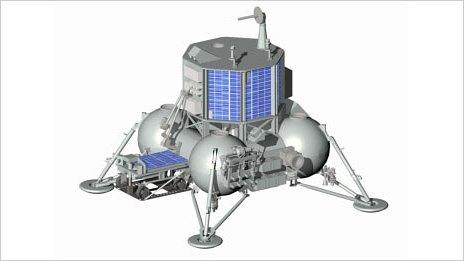Race to launch Moon landing probe
- Published

Russia's four-legged lunar platform will release an Indian-built rover
A modern-day space race to land an unmanned probe on the Moon is emerging between Russia and India on one side and China on the other.
After months of negotiations, Russian and Indian engineers have started working on a robotic mission together.
This would see the landing of a small four-wheeled rover on to the surface of the Earth's celestial neighbour.
It is set to launch in 2013, to roughly match the scheduled lunar landing of China's Chang'e-3 spacecraft.
Whichever team gets there first, it would be the first human hardware to function on the lunar surface since the Soviet Luna-24 spacecraft returned to Earth with Moon's soil samples in 1976.
Known in Russia as Luna-Resource and in India as Chandrayaan-2, the joint mission will include an Indian-built lunar orbiter and the Russian-built landing platform both launched by a single Indian rocket.
The Russian-built four-legged platform will deliver around 35kg of scientific equipment to the lunar surface and release a 15kg Indian-built robotic rover.
Despite being a far cry from the 750kg Soviet Lunokhod rovers, which rolled across the lunar landscape in the 1970s, the tiny Indian electric vehicle is still expected to provide scientific data, thanks to miniaturisation of technology.
"We do understand that, first of all, it is a demonstration of the Indian presence on the surface of the Moon," Aleksandr Zakharov, a leading scientist at the Space Research Institute (IKI) in Moscow told BBC News.
"However, it will have a TV camera onboard, and we also asked our Indian partners to include a miniature manipulator, so it could sample soil beyond the reach of the robotic arm of the (stationary Russian) lander."
The rover and all of its scientific instruments are expected to be Indian-built, even though India is free to solicit foreign participation, Mr Zakharov said.
Quest for water
Russia recently put the highest priority on the Luna-Resource project in order to fulfill a 2013 launch window insisted upon by India, Russian space industry officials said.
Mr Zakharov said the work on Luna-Resource was proceeding even more actively than on Russia's own project of lunar exploration - known as Luna-Glob
By the end of this month, the Moscow-based institute is planning to finalise the selection of instruments which will comprise the scientific payload aboard the stationary Luna-Resource lander.
The main focus of the scientific instruments would be the geochemical analysis of the lunar soil, including the detection of water.
Confirming the existence of lunar water became especially important for planetary scientists in 1990s, after a US probe found signs of water ice around the lunar poles.
By doing so, scientists would not simply write an important chapter in the geological history of the Earth's natural satellite, but also provide a major imperative if humans ever attempt to establish a habitable base on the Moon.
According to Mr Zakharov, a drilling mechanism, which is being considered for the Luna-Resource mission could penetrate as deep as 1m below the surface and with some luck achieve the pioneering feat of "touching" lunar water.
To increase the chances of this happening, Russian and Indian scientists will be working to carefully select landing sites for the mission.
Although the search is expected to continue for some time, the lunar South Pole had already been singled out as a possible target, where water ice could be most abundant and lie closest to the surface.
The selection process could be facilitated by data from India's first lunar mission - Chandrayaan-1 - which orbited the Moon in 2008.
According to Mr Zakharov, landing at the poles the Moon could be arranged so that it ensures the largely uninterrupted communications of the spacecraft with ground control.
At the same time, the Moon's polar regions are largely an enigma to scientists, as all previous lunar landings were limited to equatorial and middle latitudes.
Along with the quest for water, the Luna Resource mission could improve understanding of the internal composition of the Moon and its orbital movement with the help of a seismometer and a laser reflector.
Also on the short list of potential payloads is a radio beacon, which could facilitate lunar landings for future missions. Up to 10 scientific instruments could be placed aboard the lander, Zakharov said.
As Russia's second deep-space launch attempt after the scheduled mission to Phobos in 2011, Luna-Resource is expected to make a maximum use of scientific hardware, which had already been developed for exploration of the Martian Moon.
The IKI also expects that many of its traditional partners abroad would consider participating in the new mission. "We do talk to our usual partners in France, Germany, Sweden and other countries and we are counting on that," Mr Zakharov said.